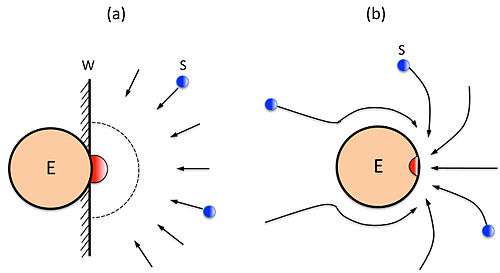Diffusion-controlled reaction
Diffusion-controlled (or diffusion-limited) reactions are reactions that occur so quickly that the reaction rate is the rate of transport of the reactants through the reaction medium (usually a solution).[1] As quickly as the reactants encounter each other, they react. The process of chemical reaction can be considered as involving the diffusion of reactants until they encounter each other in the right stoichiometry and form an activated complex which can form the product species. The observed rate of chemical reactions is, generally speaking, the rate of the slowest or "rate determining" step. In diffusion controlled reactions the formation of products from the activated complex is much faster than the diffusion of reactants and thus the rate is governed by collision frequency.
Diffusion control is rare in the gas phase, where rates of diffusion of molecules are generally very high. Diffusion control is more likely in solution where diffusion of reactants is slower due to the greater number of collisions with solvent molecules. Reactions where the activated complex forms easily and the products form rapidly are most likely to be limited by diffusion control. Examples are those involving catalysis and enzymatic reactions. Heterogeneous reactions where reactants are in different phases are also candidates for diffusion control.
One classical test for diffusion control is to observe whether the rate of reaction is affected by stirring or agitation; if so then the reaction is almost certainly diffusion controlled under those conditions.
Applications in biology

The theory of diffusion-controlled reaction was originally utilized by R.A. Alberty, Gordon Hammes, and Manfred Eigen to estimate the upper limit of enzyme-substrate reaction.[2][3] According to their estimation,[2][3] the upper limit of enzyme-substrate reaction was 109 M−1sec−1.
In 1972, it was observed that in the dehydration of H2CO3 catalyzed by carbonic anhydrase, the second-order rate constant obtained experimentally was about 1.5 × 1010 M−1sec−1,[4] which was one order of magnitude higher than the upper limit estimated by Alberty, Hammes, and Eigen based on a simplified model.[2][3]
To address such a paradox, Prof. Kuo-Chen Chou and his co-workers proposed a model by taking into account the spatial factor and force field factor between the enzyme and its substrate and found that the upper limit could reach 1010 M−1sec−1,[5][6][7] and can be used to explain some surprisingly high reaction rates in molecular biology.[4][8][9]
The new upper limit found by Chou et al. for enzyme-substrate reaction was further discussed and analyzed by a series of follow-up studies.[10] [11] [12]
A detailed comparison between the simplified Alberty-Hammes-Eigen’s model (Figure 1a) and the Chou’s model (Figure 1b) in calculating the diffusion-controlled reaction rate of enzyme with its substrate, or the upper limit of enzyme-substrate reaction, was elaborated in the paper.[13]
References
- ↑ Atkins, Peter (1998). Physical Chemistry (6th ed.). New York: Freeman. pp. 825–8.
- 1 2 3 Alberty, Robert A.; Hammes, Gordon G. (1958). "Application of the Theory of Diffusion-controlled Reactions to Enzyme Kinetics". Journal of Physical Chemistry. 62 (2): 154–9. doi:10.1021/j150560a005.
- 1 2 3 Eigen, Manfred; Hammes, Gordon G. (2006). "Elementary Steps in Enzyme Reactions (as Studied by Relaxation Spectrometry)". In Nord, F. F. Advances in Enzymology and Related Areas of Molecular Biology. pp. 1–38. doi:10.1002/9780470122709.ch1. ISBN 978-0-470-12270-9. OCLC 777630506.
- 1 2 Koenig, Seymour H.; Brown, Rodney D. (1972). "H2CO3 as Substrate for Carbonic Anhydrase in the Dehydration of HCO3−". Proceedings of the National Academy of Sciences of the United States of America. 69 (9): 2422–5. Bibcode:1972PNAS...69.2422K. doi:10.1073/pnas.69.9.2422. JSTOR 61783. PMC 426955
 . PMID 4627028.
. PMID 4627028. - ↑ Chou, Kuo-Chen; Jiang, Shou-Ping (1974). "Studies on the rate of diffusion-controlled reactions of enzymes. Spatial factor and force field factor". Scientia Sinica. 27 (5): 664–80. PMID 4219062.
- ↑ Chou, Kuo-Chen (1976). "The kinetics of the combination reaction between enzyme and substrate". Scientia Sinica. 19 (4): 505–28. PMID 824728.
- ↑ Li, TT; Chou, KC (1976). "The quantitative relations between diffusion-controlled reaction rate and characteristic parameters in enzyme-substrate reaction systems. I. Neutral substrates". Scientia Sinica. 19 (1): 117–36. PMID 1273571.
- ↑ Riggs, Arthur D.; Bourgeois, Suzanne; Cohn, Melvin (1970). "The lac represser-operatorinteraction: III. Kineticstudies". Journal of Molecular Biology. 53 (3): 401–17. doi:10.1016/0022-2836(70)90074-4. PMID 4924006.
- ↑ Kirschner, Kasper; Gallego, Ernesto; Schuster, Inge; Goodall, David (1971). "Co-operative binding of nicotinamide-adenine dinucleotide to yeast glyceraldehyde-3-phosphate dehydrogenase: I. Equilibrium and temperature-jump studies at pH 8.5 and 40 °C". Journal of Molecular Biology. 58 (1): 29–50. doi:10.1016/0022-2836(71)90230-0. PMID 4326080.
- ↑ Chou, Kuo Chen; Zhou, Guo Ping (1982). "Role of the protein outside active site on the diffusion-controlled reaction of enzymes". Journal of the American Chemical Society. 104 (5): 1409–13. doi:10.1021/ja00369a043.
- ↑ Payens, T.A.J. (1983). "Why are enzymes so large?". Trends in Biochemical Sciences. 8: 46. doi:10.1016/0968-0004(83)90382-1.
- ↑ Zhou, Guozhi; Wong, Ming-Tat; Zhou, Guo-Qiang (1983). "Diffusion-controlled reactions of enzymes: An approximate analytic solution of Chou's model". Biophysical Chemistry. 18 (2): 125–32. doi:10.1016/0301-4622(83)85006-6. PMID 6626685.
- ↑ Zhou, Guo-Qiang; Zhong, Wei-Zhu (1982). "Diffusion-Controlled Reactions of Enzymes". European Journal of Biochemistry. 128 (2–3): 383–7. doi:10.1111/j.1432-1033.1982.tb06976.x. PMID 7151785.